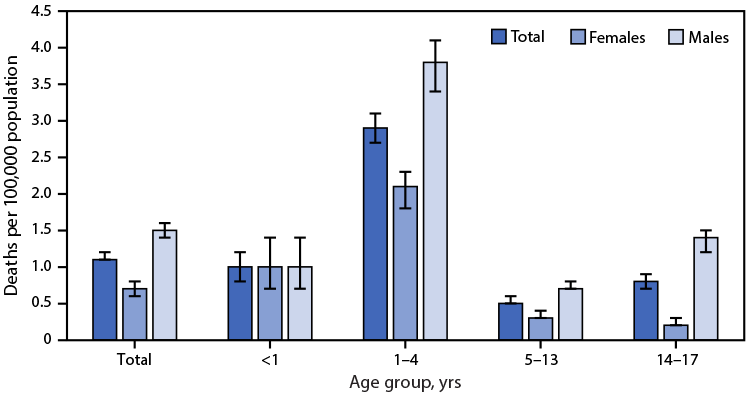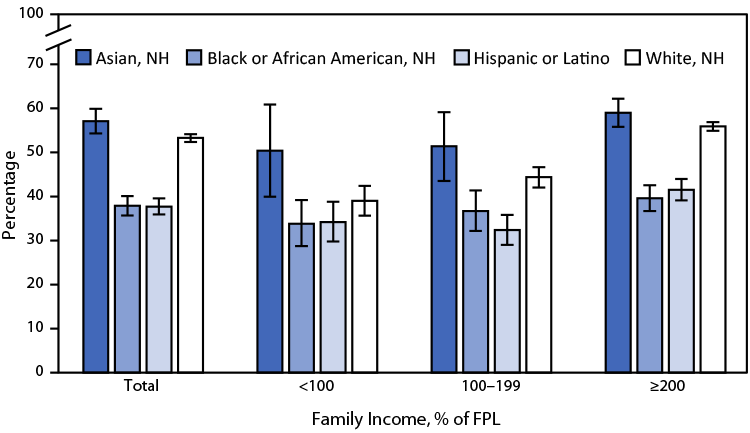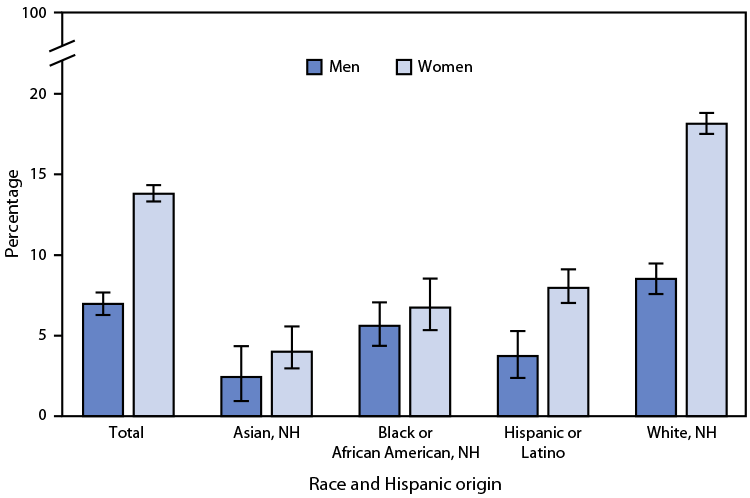NCHS: A Blog of the National Center for Health Statistics
QuickStats: Unintentional Drowning Death Rates of Children and Adolescents Aged 0–17 Years, by Sex and Age Group — United States, 2020–2021

During 2020–2021, the unintentional drowning death rate was 1.1 deaths per 100,000 population among children and adolescents aged 0–17 years. Rates were higher among males (1.5) than females (0.7). Among children aged <1 year, boys and girls had similar unintentional drowning death rates (1.0), whereas rates were higher for males than for females among those Read More >
Posted on byQuickStats: Percentage of Children and Adolescents Aged ≤17 Years Who Had Ever Received a Diagnosis of Concussion or Brain Injury, by Sex and Age Group — National Health Interview Survey, United States, 2022

In 2022, 2.3 million (3.2%) children and adolescents aged ≤17 years had ever received a diagnosis of a concussion or brain injury. Diagnosis of a concussion or brain injury increased with age, from 1.0% among those aged 0–5 years to 2.3% among those aged 6–11 years, and 5.9% among those aged 12–17 years. Percentages were Read More >
Posted on byU.S. Uninsured Rate Hits Record Low in First Quarter of 2023

The overall number of Americans without health insurance dropped to a record low of 7.7% in the first three months of 2023, according to analysis by the National Health Interview Survey (NHIS). This marks the first time the uninsured rate has dropped below 8% since NHIS began tracking health insurance in 2001. The findings are Read More >
Posted on byQuickStats: Percentage of Adults Aged ≥18 Years who Received an Influenza Vaccination in the Past 12 Months, by Race and Ethnicity and Family Income — National Health Interview Survey, United States, 2021

In 2021, non-Hispanic Asian (Asian) adults aged ≥18 years were the most likely to receive an influenza vaccination in the past 12 months (57.1%) followed by non-Hispanic White (White) (53.3%) adults; Hispanic or Latino (Hispanic) and non-Hispanic Black or African American (Black) adults were the least likely to receive an influenza vaccination (37.7% and 37.9%, Read More >
Posted on byQ & A from the Report Author of Repetitive Strain Injuries in Adults

Questions for Matthew Garnett, Health Statistician and Lead Author of “Repetitive Strain Injuries in Adults in the Past 3 Months: United States, 2021.” Q: Why did you decide to look at repetitive strain injuries? MG: When people tend to think about injuries, they often think of acute injuries like cuts or broken bones. However, repetitive Read More >
Posted on byQuickStats: Percentage of Children and Adolescents Aged ≤17 Years Who Have Experienced a Specified Stressful Life Event, by Type of Event and Family Income — National Health Interview Survey, United States, 2021

In 2021, 20.2% of children and adolescents in families with incomes <200% of FPL and 12.0% of those in families with incomes ≥200% of FPL had experienced at least one specified stressful life event. Children and adolescents in families with incomes <200% of FPL were more likely than those in families with incomes ≥200% of Read More >
Posted on byCo-Involvement of Opioids in Drug Overdose Deaths involving Cocaine and Psychostimulants, 2011-2021

NCHS released a new report, “Co-Involvement of Opioids in Drug Overdose Deaths involving Cocaine and Psychostimulants, 2011-2021,” that provides trends from 2011 through 2021 in death rates involving cocaine and rates involving psychostimulants, with and without opioid co-involvement, as well as by census region in 2021. Findings: Drug overdose death rates involving cocaine nearly quintupled, Read More >
Posted on byQuickStats: Number of Deaths from Hornet, Wasp, and Bee Stings Among Males and Females — National Vital Statistics System, United States, 2011–2021

During 2011–2021, a total of 788 deaths from hornet, wasp, and bee stings occurred (an average of 72 deaths per year). The annual number of deaths ranged from 59 (2012) to 89 (2017). Overall, 84% of deaths occurred among males. Source: National Center for Health Statistics, National Vital Statistics System, Mortality Data, 2011–2021. https://wonder.cdc.gov/Deaths-by-Underlying-Cause.html Read More >
Posted on byQuickStats: Age-Adjusted Rates of Firearm-Related Homicide, by Race, Hispanic Origin, and Sex — National Vital Statistics System, United States, 2021

In 2021, among males, Black or African American (Black) males had the highest age-adjusted rate of firearm-related homicide (52.9 deaths per 100,000 standard population), and Asian males had the lowest rate (1.5). Among females, Black females had the highest rate (7.5), and Asian females had the lowest rate (0.5). Males had higher rates than females Read More >
Posted on byNew Analysis Looks at Drug Overdose Deaths Involving Xylazine

NCHS released a new report, “Drug Overdose Deaths Involving Xylazine, 2018‒2021,” that presents trends in drug overdose death rates involving xylazine from 2018 through 2021 in the United States. The report uses an established methodology for examining death certificate literal text to identify drug overdose deaths involving xylazine that occurred in the United States among Read More >
Posted on byNew Report Looks at Pregnant Mothers with Confirmed or Presumed COVID in 14 States and D.C.

NCHS has released a new report, “Trends In Characteristics of Mothers With Confirmed or Presumed COVID-19 During Pregnancy: 14 States and The District of Columbia, July 2020‒June 2022,” that looks at changes by maternal age, educational attainment, race and Hispanic origin, and principal source of payment for the delivery. The report includes data from the Read More >
Posted on byQuickStats: Age-Adjusted Percentage of Adults Aged 50–75 Years Who Received the Recommended Colorectal Cancer Screening, by Sex and Family Income

In 2021, 71.6% of adults aged 50–75 years reported they received the recommended colorectal cancer screening, with the percentage increasing with income from 56.7% for those with family incomes <100% of FPL to 63.0% for those with family incomes 100% to <200% of FPL, and 74.9% for those with family incomes ≥200% of FPL. The Read More >
Posted on byQuickStats: Age-Adjusted Death Rates, for Pedestrians Involved in a Collision with a Motor Vehicle, by Race and Hispanic Origin — National Vital Statistics System, United States, 2021

In 2021, a total of 8,392 deaths from pedestrian-involved collisions with motor vehicles occurred. The age-adjusted death rate from such collisions was highest for American Indian or Alaska Native persons (8.2 deaths per 100,000 standard population), followed by Black or African American (4.4), Hispanic or Latino (3.0), White (1.9), and Asian (1.4) persons. Source: National Vital Read More >
Posted on bySuicide and Homicide Rates Increase Among Young Americans

NCHS released a new report that uses the most recent data from the National Vital Statistics System (NVSS) to update a previous report. The report presents trends from 2001 to 2021 in suicide and homicide rates for young people ages 10‒24 and for age groups 10‒14, 15‒19, and 20‒24. Findings: After no significant change between Read More >
Posted on byNCHS Data Brief: Mental Health Treatment Among Children Aged 5–17 Years: United States, 2021

New NCHS report describes the percentage of children aged 5–17 years who have received mental health treatment in the past 12 months by selected characteristics, based on data from the 2021 National Health Interview Survey. Mental health treatment is defined as having taken medication for mental health, received counseling or therapy from a mental health Read More >
Posted on byQuickStats: Percentage of Adults Aged ≥18 Years Who Received Care at Home from a Friend or Family Member During the Past 12 Months, by Age Group — National Health Interview Survey

During 2021, 11.9% of adults aged ≥18 years received care at home from a friend or family member during the past 12 months. The percentage of adults who received care during the past 12 months was similar among adults aged 18–44 years (9.8%) and 45–64 years (10.5%), then increased with age to 13.8% among those Read More >
Posted on byQuickStats: Percentage of Adults Aged ≥18 Years Who Have Been Bothered a Lot by Headache or Migraine in the Past 3 Months, by Sex and Age Group — National Health Interview Survey, 2021

In 2021, 4.3% of adults aged ≥18 years reported being bothered a lot by headache or migraine in the past 3 months with the percentage among women (6.2%) higher than that among men (2.2%). Percentages were higher among women than men in all age groups: 7.4% versus 2.5% in adults aged 18–44 years, 6.7% versus Read More >
Posted on byU.S. Teen Birth Rate Reached Another Historic Low in 2022

The teen birth rate in the United States decreased 3% from 2021, reaching a record low for this age group. The 2022 rates declined for both younger (ages 15–17) and older (ages 18–19) teenagers. The teen birth rate has declined every year except for two (2006 and 2007) since 1991. The new report, “Births: Provisional Read More >
Posted on byQuickStats: Age-Adjusted Percentage of Adults Aged ≥18 Years Who Take Prescription Medication for Depression, by Sex and Race and Hispanic Origin — National Health Interview Survey, United States, 2021

In 2021, among adults aged ≥18 years, women were more likely to take prescription medication for depression than were men (13.8% versus 7%). This pattern was found among non-Hispanic White (White) (18.1% versus 8.5%) and Hispanic or Latino (8.0% versus 3.7%) adults, but differences by sex were not statistically significant among non-Hispanic Black or African Read More >
Posted on byQuickStats: Percentage of Children and Adolescents Aged 5–17 Years Who Received Free or Reduced-Cost Meals at School During the Previous 12 Months, by Race and Hispanic Ethnicity and Family Income — National Health Interview Survey, United States, 2021

In 2021, 51.6% of all U.S. children and adolescents aged 5–17 years received free or reduced-cost meals at school during the previous 12 months; NH Black or African American (66.2%) and Hispanic or Latino (Hispanic) (64.4%) children and adolescents were more likely to receive free or reduced-cost meals at school than were NH White (42.7%) Read More >
Posted on byProvisional Data Shows U.S. Drug Overdose Deaths Top 100,000 in 2022

NCHS released the next set of monthly provisional drug overdose death counts that provide data through December 2022. The monthly counts are released under the Vital Statistics Rapid Release program as an interactive data visualization and are available at https://www.cdc.gov/nchs/products/vsrr/drug-overdose-data.htm. Findings: Provisional data show that the reported number of drug overdose deaths occurring in the Read More >
Posted on byU.S. Uninsured Rate Dropped 18% During Pandemic

The overall number of Americans without health insurance dropped by 5.6 million from 2019 to 2022. These findings are included in a new report released by CDC’s National Center for Health Statistics (NCHS). The findings are featured in the report, “Health Insurance Coverage: Early Release of Estimates from the National Health Interview Survey, 2022.” It Read More >
Posted on byQuickStats: Age-Adjusted Percentage of Adults Aged ≥18 Years Who Had a Repetitive Strain Injury During the Past 3 Months, by Sex and Race and Hispanic Origin

In 2021, 9.0% of men and 8.9% of women aged ≥18 years had a repetitive strain injury during the past 3 months. Non-Hispanic White men (10.1%) were more likely to have a repetitive strain injury than were non-Hispanic Asian (Asian) (7.6%), non-Hispanic Black or African American (Black) (6.6%), and Hispanic or Latino (Hispanic) (6.4%) men. Read More >
Posted on byNew Updates to Interactive “Stats of the States” Page

The CDC National Center for Health Statistics web page “Stats of the States” has been updated to include the latest state-based final data on selected vital statistics topics, including: General fertility rates Teen birth rates Selected other maternal and infant health measures Marriage & divorce rates Leading causes of death Other high profile causes of Read More >
Posted on byQuickStats: Percentage of Adults Who Were in Families Having Problems Paying Medical Bills During the Previous 12 Months, by Race, Hispanic Origin, and Selected Asian Subgroups

During 2020–2021, the percentage of U.S. adults who were in families having problems paying medical bills during the previous 12 months was 11.3%. Non-Hispanic Asian adults (5.7%) were the least likely to be in families having problems paying medical bills, followed by non-Hispanic White (10%), Hispanic or Latino (13.5%), and non-Hispanic Black or African American Read More >
Posted on by
